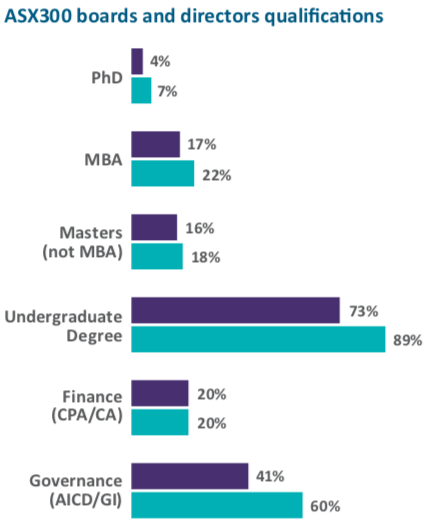What does a female board director look like? Well for those holding board seats on the ASX 300, she’s more likely than her male counterparts to have an MBA, a PhD and basically any formal qualifications at all. She’s also more likely to be younger.
That’s according to The Board Diversity Index, which explores five key areas of board diversity, including gender diversity, cultural diversity, skills diversity, age diversity, and tenure. It’s published by the Governance Institute of Australia in partnership with Watermark Search International.
On examining the qualifications of ASX 300 board members, they found that four per cent of men had PhDs compared with seven per cent of women. 17 per cent of men had MBAs compared to 22 per cent of women. And 41 per cent of men held governance qualifications, compared with 60 per cent of women.
Still, the average age of female board directors is lower than men, at 57.9 and 61.5 respectively.
On gender diversiy in general, things are moving in the right direction, albeit slowly. Of the 2004 board seats available at the companies surveyed, 561 are now occupied by women, up by 28 from the previous year. There are now 20 companies with boards that are now more than 50 per cent female (the list is below), up from 16 last year. There are still 108 boards with either zero or one woman on them in 2020, down from 170 in 2016.
The number of boards chaired by women has also increased, for the third year in a row.
But the numbers are not so good when you examine new companies entering the ASX. Of the 30 companies that arrived on the ASX300 this year, bringing 156 board seats with them, just 24 of those board seats were filled by women. The gender split is better in the ASX 50 (with 34 per cent of board seats held by women) but goes backwards on the ASX 201 to 300, with just 23 per cent of seats held by women.

Unfortunately on cultural diversity on boards, things have moved slightly in the wrong direction.
The data shows the number of board directors from non-Anglo-Celtic cultural backgrounds has fallen over the past year, from an already tiny 5.4 per cent to 5 per cent on ASX 300 companies.
The report authors, including Watermark Managing Partner David Evans and GIA CEO Megan Motto, say that 2020 is a year without corporate precedence and board diversity matters. “We believe that boards with a broad range of views, skills, educations and backgrounds will be in a better position to cope with the ensuing uncertainty.”
They say that in 2020 and beyond, they’re looking forward to the business world repopening, having used the opportunity that COVID-19 presented to rethink outdated business models, and address a ‘new normal’ that fixes some of the diversity imbalances of the past. They hope to see more flexible and nimble workforces and “a greater recognition that diversity on boards is a major positive for our society, and also is proving to be great for business.”
These are the boards that are more than 50 per cent female:
- Commonwealth bank
- Woolworths Group
- Fortescue Metals Group
- Mirvac Group
- Auckland International Airport
- Medibank
- Bluescope Steel
- Spark New Zealand
- Altium Limited
- Ansell Limited
- Nib holdings
- Metcash
- Abacus Property Group
- CSR Limited
- Bapcor
- Lifestyle Communities
- FlexiGroup
- Asaleo Care
- Myer Holdings
- Japara Healthcare

